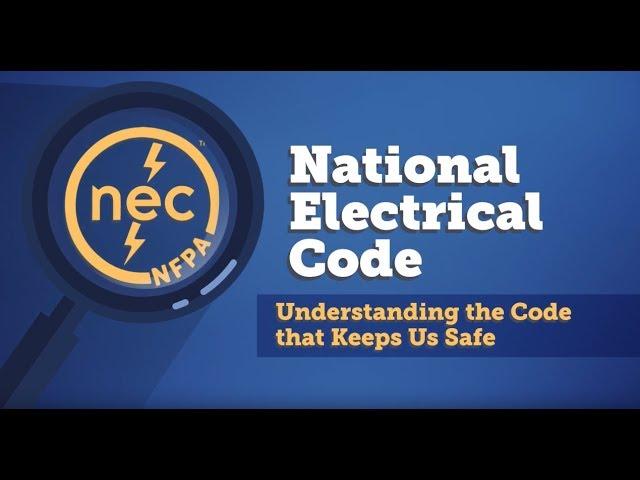
National Electrical Code: Understanding the Code that Keeps us Safe
Electricity is everywhere. It’s the greatest achievement of mankind and it affects every aspect of our lives.
As the world becomes interconnected, more and more areas of our lives will soon be powered by electricity.
But it isn’t until we lose power that we realize just how much we take electricity for granted.
Imagine if your phone required a special outlet that no other device could use.
Without standards, this would be the reality. Standards allow us to plug in any device into any outlet, knowing it will work safely.
Standards are the foundation of our electrified lives. They allow safety, efficiency, and compatibility for products we use every day and are put into place through safety codes, like the National Electrical Code.
The NEC sets the minimum standards for safe electrical installation, is updated every three-years, and ensures that the electrical systems behind our walls are safe.
When was the last time you entered a public building and felt unsafe? Strict codes and standards keep these buildings updated through regular inspections and upgrades.
Public buildings are generally safer than our homes because homes are not required by law to have regular electrical inspections. This means that the responsibility remains solely in the hands of the owner.
Did you know that there have been 15 new editions of the NEC since the year the average American home was built?
Homes not up to date with the latest safety codes are not adequately protected against fire and electrical hazards and may not be equipped to handle today’s electrical needs.
In the last 40 years, NEC requirements have reduced home electrocutions by a staggering 83%.
Many homeowners attempt to save money by performing “do-it-yourself” repairs or upgrades that may not be up to code, or worse- avoid completing repairs at all.
A recent study showed that a qualified electrician could upgrade a home’s electrical system from the 2011 to the 2017 NEC for an average cost of under $200.
ESFI strongly encourages states and jurisdictions to adopt the most recent codes and standards to protect residents with the latest advancements in safety technology.
Statistically, states with older versions of safety codes endanger their communities and increase the likelihood of workplace deaths and home fires.
The National Electrical Code saves lives. It’s crucial that we all adopt these minimum standards of electrical safety.
As the world becomes interconnected, more and more areas of our lives will soon be powered by electricity.
But it isn’t until we lose power that we realize just how much we take electricity for granted.
Imagine if your phone required a special outlet that no other device could use.
Without standards, this would be the reality. Standards allow us to plug in any device into any outlet, knowing it will work safely.
Standards are the foundation of our electrified lives. They allow safety, efficiency, and compatibility for products we use every day and are put into place through safety codes, like the National Electrical Code.
The NEC sets the minimum standards for safe electrical installation, is updated every three-years, and ensures that the electrical systems behind our walls are safe.
When was the last time you entered a public building and felt unsafe? Strict codes and standards keep these buildings updated through regular inspections and upgrades.
Public buildings are generally safer than our homes because homes are not required by law to have regular electrical inspections. This means that the responsibility remains solely in the hands of the owner.
Did you know that there have been 15 new editions of the NEC since the year the average American home was built?
Homes not up to date with the latest safety codes are not adequately protected against fire and electrical hazards and may not be equipped to handle today’s electrical needs.
In the last 40 years, NEC requirements have reduced home electrocutions by a staggering 83%.
Many homeowners attempt to save money by performing “do-it-yourself” repairs or upgrades that may not be up to code, or worse- avoid completing repairs at all.
A recent study showed that a qualified electrician could upgrade a home’s electrical system from the 2011 to the 2017 NEC for an average cost of under $200.
ESFI strongly encourages states and jurisdictions to adopt the most recent codes and standards to protect residents with the latest advancements in safety technology.
Statistically, states with older versions of safety codes endanger their communities and increase the likelihood of workplace deaths and home fires.
The National Electrical Code saves lives. It’s crucial that we all adopt these minimum standards of electrical safety.
Тэги:
#Electrical_Code #National_Electrical_Code #Fire_Safety #Electrical_Safety #NFPA_70Комментарии:
National Electrical Code: Understanding the Code that Keeps us Safe
Electrical Safety Foundation International
Car Crashes Compilation – Watch These Insane Bad Drivers #406
Safe Driving Academy
this scene never gets old #goblin #kdrama
Mamma's girl
Workshop Tour | Woodworking Machine Rundown of My New Shop
Dan Lee Boatbuilding
PSYCHOLOGIA TO TWOJA WYMÓWKA! *TRADING*
Pablo - "Dzungla Pablo"
Vanilla Ice Cream Recipe By Food Fusion
Food Fusion
Best Neighborhoods in Longmont Colorado (Where to Live in Longmont)
Life On The Front Range


![[tvN] 화제의 작품들로 큰 사랑받은 tvN의 특별한 연말 선물 뻔한 시상식 대신 tvN이 준비한 연말 이벤트는 과연? #같이달려tvN [tvN] 화제의 작품들로 큰 사랑받은 tvN의 특별한 연말 선물 뻔한 시상식 대신 tvN이 준비한 연말 이벤트는 과연? #같이달려tvN](https://ruvideo.cc/img/upload/c254UTFWUDJaOV8.jpg)























